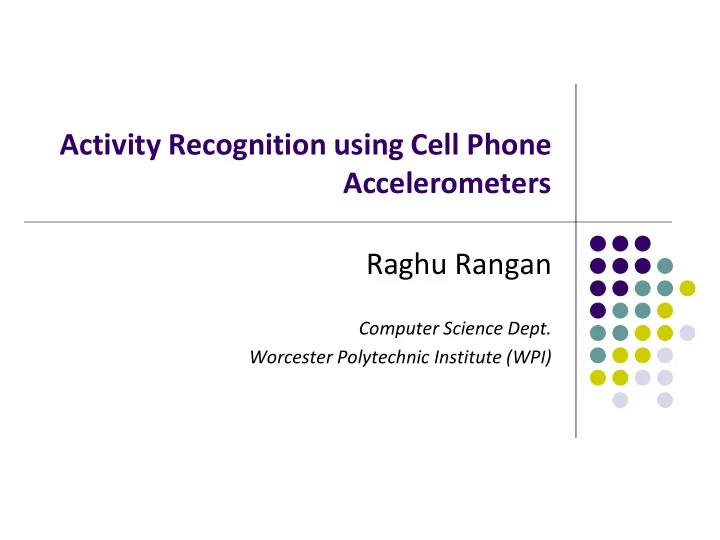

Activity Recognition using Cell Phone Accelerometers Raghu Rangan Computer Science Dept. Worcester Polytechnic Institute (WPI)
Introduction Today’s mobile devices are filled with a number of sensors i.e. GPS, audio sensors, light sensors, accelerometers These sensors open up new opportunities Especially in data mining research and applications
Accelerometers All modern smartphones contain accelerometers Specifically tri-axial accelerometers (x,y,z) Accelerometers are capable of detecting device orientation Accelerometers included in devices initially to support: Advanced game play Automatic screen rotation But there are a number of other applications for this sensor
Goal Create a system which uses this data to perform activity recognition Using the commercially available accelerometer in smartphones
Related Work Accelerometer-based activity recognition is not new Earliest works (i.e. Bao & Intille) use multiple accelerometers Used 5 bi-axial accelerometers worn by each user Found that sensor on thigh was the most powerful Another work (Krishna et. al.) claim that multiple accelerometers necessary for activity recognition
Related Work Combination of accelerometers and other sensors Use heart monitor data (Tapia et. al.) Parkka et. al. created system using 20 different sensors Combination of accelerometer, angular velocity sensor, and digital compass (Lee and Mase) “eWatch” devices These systems are not very practical
Related Work Focus of this work is on using a single accelerometer Some work has been done on that Work has been done to use the smartphones Some work just used the phone as a data collector from external sensors (i.e. “MotionBands”) Others have used multiple phone sensors Various degrees of accuracy Model is trained for a specific user, not universal
Methodology (Data Collection) Data collected from 29 subjects Phone was carried in the front pant leg pocket For all activities Accelerometer data collected every 50ms 20 samples/second
Methodology Raw time-series data cannot be used with classification algorithms Data divided into 10-second segments Chose duration because it captured repetitions of motion Generated features based on the 200 readings in each segment
Methodology (Feature Generation)
Methodology (Activities) Six activities considered Walking, jogging, ascending stairs, descending stairs, sitting, and standing Repetitive motions should make activities easier to identify
Methodology (Activities)
Methodology (Activities)
Methodology (Activities)
Results 3 classification techniques using WEKA Able to achieve high accuracies (>90%) for most activities Stair climbing activity difficult to identify
Closer Look at Results
Results To limit confusion between ascending and descending Combine both activities together Results are much better But stair climbing is still difficult to identify
Conclusion Demonstrated that activity detection can be highly accurate using smart phone accelerometers Most activities recognized over 90% of the time
Future Work Platform and data to be available to public Activity recognition improvements Recognize bicycling and car-riding Obtain more training data Additional and more sophisticated features Look at impact of carrying phone not in pant pocket Look at possibility of displaying results in real- time
References Bao, L. and Intille, S. 2004. Activity Recognition from User- Annotated Acceleration Data. Lecture Notes Computer Science 3001 , 1-17. J48 Classification http://monkpublic.library.illinois.edu/monkmiddleware/public /analytics/decisiontree.html Logistic Regression, Wikipedia , http://en.wikipedia.org/wiki/Logistic_regression Multilayer Perceptron, Wikipedia , http://en.wikipedia.org/wiki/Multilayer_perceptron
QUESTIONS?
Recommend
More recommend